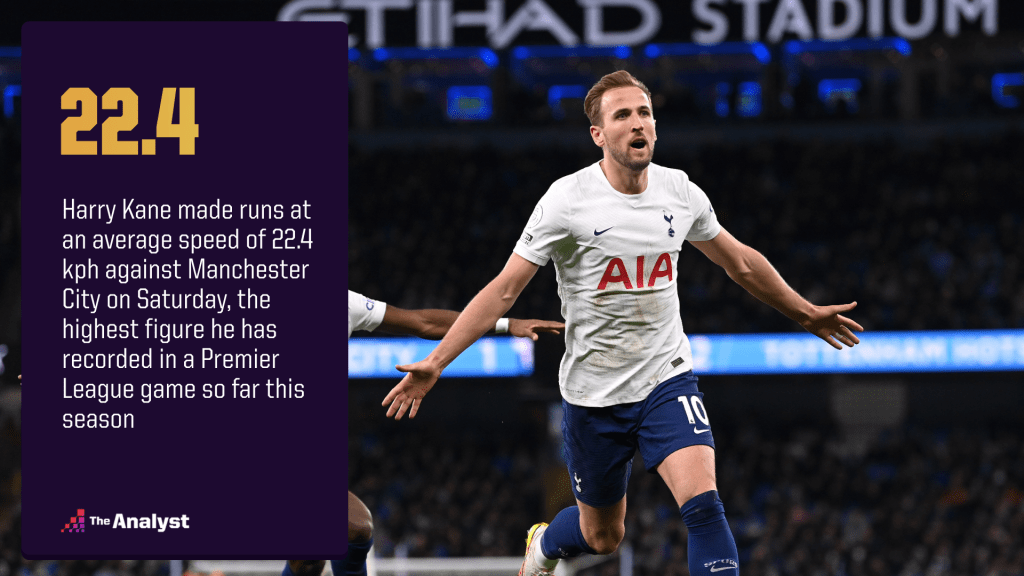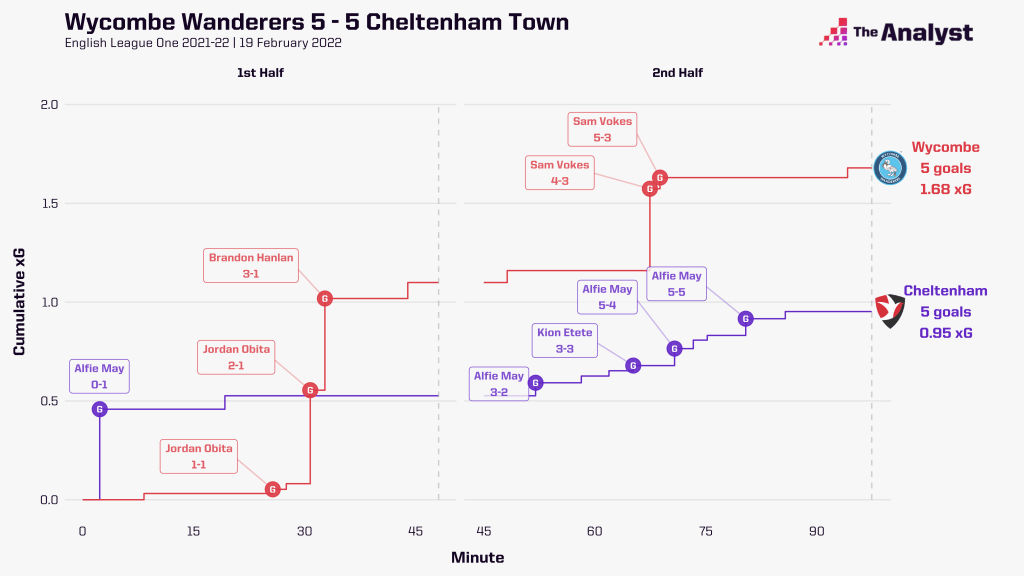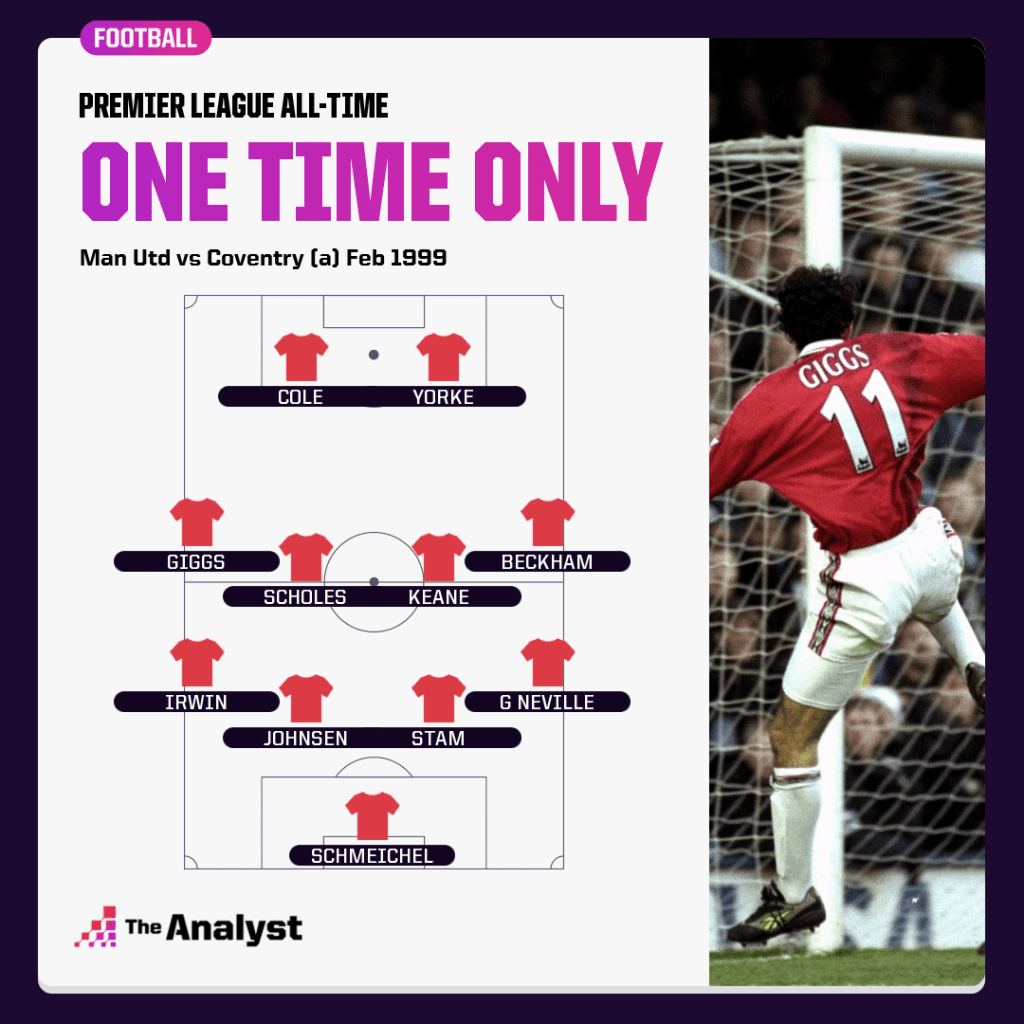Fitter, Happier, More Productive
Harry Kane is back at the top of his game. His performance away at Manchester City on Saturday was one of the finest by any Premier League striker in recent memory, the Tottenham man scoring twice, having another ruled out by VAR and being responsible for a series of audacious passes. In a game in which Spurs understandably spent a lot of time defending, Kane’s decisive contributions required him to show the sort of mobility and fitness that perhaps has been absent from his game in the last 12 months.

Kane has already stated that his fitness has improved significantly since Antonio Conte took over as Tottenham manager, and the numbers back up that claim. Against City Kane averaged a speed of 22.4 kph in his runs, his best figure of the season, while the average length of those runs was 4.95 seconds, again a season high. Whether playing at the stadium he hoped would be his new home ground was a factor in this or not only Kane can say, but a mobile, lean Kane absolutely puts him back in the frame when talking about the best centre-forwards in world football.
The Goalden Touch
In recent seasons Romelu Lukaku has been justifiably in that conversation about the planet’s best strikers, but the Belgian is enduring a tough first campaign back with Chelsea. Since joining West Brom in 2011-12 he has never ended a season with fewer than 10 league goals, but is stuck on five for Thomas Tuchel’s side, and once Opta data flashed around the world, informing everyone that Lukaku had made two touches in the first half against Crystal Palace and a total of seven in the game, there was barely a Twitter account that wasn’t eager to tell you about it.
Some would say that not having many touches isn’t necessarily a bad thing, if you are still producing goals or assists. And a quick glance at the data would initially back up that premise because since 2003-04, 14 players have made 10 touches or fewer in a Premier League match and scored twice. But the average playing time of those 14 is a mere 21 minutes. What we’re talking about here effective substitutes, and yes, Adam Le Fondre is one of them. It’s a similar story with assists, with two players making 10 or fewer touches in a game but still creating two goals: Eyal Berkovic for Portsmouth vs WBA in 2004 and Harvey Barnes for Leicester against Palace in 2020. Their time on pitch? 17 and 15 minutes respectively.
Let’s say that Lukaku, centre-forward for the newly crowned world champions, away at Crystal Palace, should be looking to get one goal and one assist in 90 minutes at Selhurst Park to hit par. What’s the fewest amount of touches he needs to do so? Premier League data tells us that three strikers have had fewer than 20 touches in a 90 minute appearance and both scored and assisted in that game. Jermain Defoe for Sunderland against Hull in 2016 (18 touches), Teemu Pukki for Norwich vs Chelsea in 2019 (15 touches) and, inevitably, Jamie Vardy against Norwich in 2021 (19 touches). So Lukaku’s total of seven needs to be more than doubled if he is to make an ephemeral but still decisive contribution. Given he made more than 50 touches on 17 different occasions as an Everton player (but not with any other Premier League club), it does lend further credence to the theory that Chelsea simply aren’t using Lukaku in the right way.
Ten Goals, One Point
Some weekends drift by in a mist of 2-1s and 1-0s, while some throw up the sort of scoreline many enjoyed/endured at Wycombe on Saturday. Gareth Ainsworth’s team scored five times, but then so did visitors Cheltenham Town, as the game ended in that rarest of scorelines, the 5-5 draw. It was only the 37th 5-5 in English league history, and the first ever in the third tier in the non-regionalised era (Darlington 5-5 Hartlepools [sic] in the Third Division North in 1936 the most recent example before this weekend). Victorian football enthusiasts might recall that Blackburn’s first ever league game, back in 1888, ended 5-5 against Accrington, while Grimsby Town ultras still talk about the 1932-33 season, one that saw them draw 5-5 twice in the space of 84 days.
As you might imagine, more than half of English football’s 5-5 draws came before the Second World War, and, after a brief renaissance in the 1960s, the 5-5 virtually died out. Between QPR and Newcastle doing it in 1984 and a 5-5 between Chesterfield and Crewe in 2010 there was only one other example, an Oxford vs Portsmouth game in 1992. But the last decade has seen a resurgence in the 10 goal draw scene, with five of them (including Wycombe vs Cheltenham) since 2013, a run that started with Alex Ferguson’s last game as Manchester United manager and also includes a famous 5-5 between former continental champions Aston Villa and Nottingham Forest.
Meanwhile, the wait for the third 6-6 in English league history goes on. Leicester and Arsenal shared 12 goals in 1930, and Charlton and Middlesbrough did the same in 1960. Anyone who saw the defending at Adams Park on Saturday would probably agree that this game was definitely a missed opportunity to reach 6-6, or perhaps even the semi-mythical 7-7.

Fergie’s XI
Sunday marked the 23rd anniversary of Manchester United fielding for the only time in the Premier League what many view as the classic treble-era starting XI. It’s a piece of information that continues to cause shock and awe when people find out, and you can read much more about it here.

